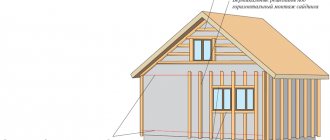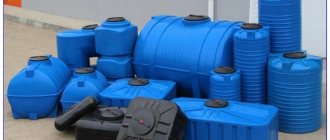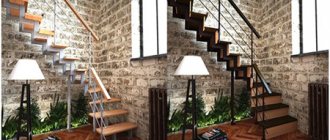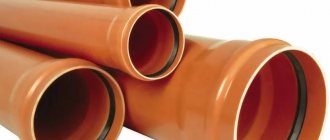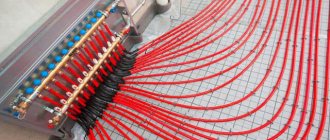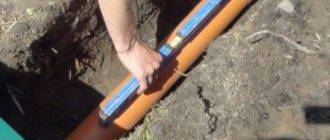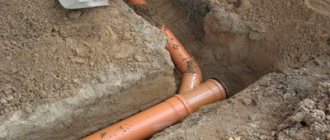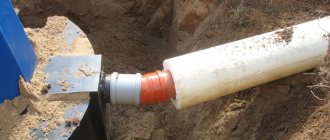Even before designing water heating, a decision must be made on the material for the pipes. Currently, in Russia, preference is given to polymer pipes, less often - metal-plastic, and even less often - stainless steel. Abroad, copper pipes are most often used for heating. They are often used for wiring water systems in private homes. Many years of experience have shown that copper analogues have the best ratio in terms of reliability/practicality.
Table of steel pipe sizes - what is the diameter of such pipes
According to one of the dimensional characteristics, steel pipes differ in diameter, that is, cross-section. Classifying them according to this indicator and wall thickness allows you to create projects and calculations for transporting any liquid through pipelines. In this article we will try to figure out what diameters and sizes of metal pipes can be found.
Standard pipe diameters and measurement systems
The use of standard pipe sections when creating various types of pipelines greatly simplifies the development of the projects themselves by specialists.
Before you figure out what the main pipe sizes are and in what systems they can be used, you should take a closer look at the leading dimensional characteristics.
It is worth noting that the pipe diameters are determined specifically based on the above parameters in accordance with technical specifications and state standards.
These values are extremely important, because for a certain pipe diameter according to GOST you can find out about the corresponding thickness of their walls.
Diameter classification
Let's consider the types of diameters of steel pipes:
- Conditional (Du, Dy) - is the internal diameter of the pipe (mm), or a rounded value (in inches).
- Nominal (Dn, Dn).
- External diameter. The determination, as a rule, is carried out according to this parameter: 5-102 mm – pipes of small cross-section; 102-426 mm – medium-section pipes; 426 mm and more – large cross-section pipes.
- Inner diameter is also considered an important parameter that also applies to connecting fittings.
In addition to the huge number of steel pipes on offer that can be found on sale, pipes made from various types of plastic are currently used in almost all areas of construction. In this regard, regulatory documentation was prepared, among which there is a table with the diameters of steel pipes and their correspondence to analogues made of polymers.
Thanks to such tables, you can select the right pipe with great accuracy during the design of any transport system.
Measuring systems
The correspondence of the diameters of pipes of various types in both units of measurement can be found in the corresponding table.
When creating water and gas supply systems, steel pipes are currently still widely used. The cross-section of such pipes is measured in inches, for example: 2.4″ or 4″, or in fractions: 1 2/3 or 5/8″. In the process of assembling a pipeline whose pipe cross-section is marked in inches, you will not have any difficulties.
However, if there is a need to change or install combined systems (steel with copper or plastic pipes), a table of steel pipe sizes, that is, their sections, will be the best help for a specialist to correctly determine the required parameters. These standards contain the metric values of steel pipes and the corresponding cross-sections of plastic pipes.
According to standards adopted in the vast majority of countries, the internal diameter of pipes is measured in millimeters. At the same time, marking pipes in inches is widespread, which is considered to be equal to 2.54 cm.
Installation of a water supply system for residential buildings often involves the use of steel pipes with an internal cross-section of 15, 20 or 32 mm.
Large-section pipes made of steel and cast iron (non-pressure), used for the construction of sewerage systems, have a cross-section equal to 50/100 mm.
The importance of selecting the correct diameter of pipes to be laid
Thanks to the exact nominal diameter of the pipe for installing the water supply system, you can find out the amount of water transported
For everyday purposes, being aware of all the nuances associated with the applicability of pipe diameters in certain situations is very important.
For example, if there is a need to carry out maintenance on the heating system of a private house, the cross-section of the pipes is determined so that in winter the heating of the entire territory is the same.
The dimensions of steel, aluminum-plastic and PP pipes can be easily calculated without anyone’s help, and without even using correspondence tables.
To determine the cross-section of a pipe for use in heating systems, you can use the formula, which is deciphered as described below.
- D – internal section of the selected pipes;
- Q – heat flow, expressed in kilowatts;
- V – coolant velocity, m/s;
- DT is the temperature difference at both ends of the system, measured in ℃;
- sqrt – square root.
The table of metal pipe sizes is very important when calculating the cross-section of steel pipes. This way you will be able to clearly optimize your work, no unforeseen nuances will arise in the process, and you will be confident in the success of its implementation. In addition, you will spend your money wisely and save a lot of working time.
High pressure crimp connections
Advances in bonded crimp technology and the development of O-ring materials are allowing bonded crimp connections to be used for high pressure applications. However, high pressure systems require a slightly different jaw configuration.
The result of manufacturing a connecting unit using the 360º double crimping technique
Bonded crimp connections for low pressure piping, process piping and non-medical compressed gas lines use a single standard hexagonal pressing shape.
Higher pressure bonding crimp connections require the use of specially designed press fittings and clamping jaws to provide a 360° double crimp on the fitting.
Method #4: Push-connect
A distinctive feature of the push-insert assembly method is that installation does not require any additional tools, burners, special fuel gases or electricity. Push-fit assembly is ensured by an integrated elastomer seal and stainless steel grip ring.
Convenient in all respects and quite practical for operation, the method of assembling a unit by inserting pressure (push-connect)
Typical pressure and temperature ranges for push-in units are shown in the table:
| Assembly type | Pressure range, kPa | Temperature range, ºC |
| Press insertion, D = 12.7 – 50.8 mm | 0 – 1375 | minus 18 / plus 120 |
There are two common types of fittings for this type of assembly. Both options create strong, reliable assembly assemblies. However, while one type of push-in fitting allows the assembly to be easily removed after installation, such as for system maintenance, the other does not support this configuration. This is where the fittings differ from one another.
Types of fittings for connections by insertion by pressing: on the left - collapsible design; on the right – non-demountable design
Before assembling the unit, it is necessary to complete all preparatory procedures with the copper pipe, as already described above
Here, special care should be taken to clean the beveled end of the copper pipe using sandpaper, nylon abrasive cloth or plumber's cloth. These actions ensure the integrity of the sealing gasket when inserting the copper pipe into the fitting body
Assembly involves performing a rigid pushing, simultaneously twisting movement directed into the body of the fitting. The movement of the copper pipe into the fitting is carried out until the copper pipe rests against the back of the fitting cup. This point is usually indicated by a previously made insertion depth mark on the surface of the copper.
Using information: Cooper
What is needed for soldering copper pipes
Soldering copper pipes, which is not difficult to do with your own hands, does not require expensive equipment or any special materials. In order to carry it out correctly, you will need the following equipment.
A burner that will heat the solder and the section of pipes where they will be connected. Such a burner is usually supplied with propane gas, the pressure of which is regulated using a welding reducer. Special device for cutting copper pipes. Since products made from this metal are very soft, they should be cut gently enough so as not to crush the walls. The modern market offers pipe cutters of various models, differing in both their functionality and technical capabilities.
The design of individual models of such devices, which is important, allows them to be used even for working in hard-to-reach places. A pipe expander is a device that allows you to expand the diameter of a copper pipe, which is necessary in order to perform soldering better. Various systems mounted from copper pipes use elements of the same cross-section, and in order to connect them efficiently, it is necessary to slightly increase the diameter of one of the elements being connected. This is precisely the problem that a device such as a pipe expander solves.
This is precisely the problem that a device such as a pipe expander solves.
Copper pipe flaring kit
A device for chamfering the ends of copper pipes. After trimming, burrs remain on the ends of the parts, which can interfere with obtaining a high-quality and reliable connection. To remove them and give the ends of the pipes the required configuration, a bevel remover is used before soldering. There are two main types of chamfering devices on the market today: those placed in a round body and those made in the form of a pencil. More convenient to use, but also more expensive, are round devices that can process soft copper pipes with a diameter of no more than 36 mm. To properly prepare copper pipes for soldering, it is necessary to remove all contaminants and oxides from their surface. For these purposes, brushes and brushes are used, the bristles of which are made of steel wire. Typically, brazing of copper pipes is performed with hard solder, which can be high- or low-temperature. High-temperature solder is copper wire containing about 6% phosphorus. Such wire melts at a temperature of 700 degrees, while for its low-temperature type (tin wire) 350 degrees is sufficient. The technology for soldering copper pipes involves the use of special fluxes and pastes that perform a protective function. Such fluxes not only protect the seam being formed from the formation of air bubbles in it, but also significantly improve the adhesion of the solder to the pipe material.
In addition to flux, solder and other basic elements, to solder copper pipes you will also need additional tools, which can be found in every workshop or garage. To solder or cook copper products, additionally prepare:
- regular marker;
- roulette;
- building level;
- a small brush with stiff bristles;
- hammer.
Before starting work, it is also important to decide how to solder copper pipes. There can be two main options: soldering copper with hard solder (used less frequently) and using soft solder. When addressing this issue, it is important to proceed from the fact that there are requirements for the use of one or another type of solder
Thus, hard solders are used for soldering elements of refrigeration units and air conditioners. In all other cases (water supply systems, heating systems, etc.) tin wire can be used. But no matter what technology is chosen, it should be remembered that flux is necessary in any case
When addressing this issue, it is important to assume that there are requirements for the use of one or another type of solder. Thus, hard solders are used for soldering elements of refrigeration units and air conditioners
In all other cases (water supply systems, heating systems, etc.) tin wire can be used. But no matter what technology is chosen, it should be remembered that flux is necessary in any case.
Cleaners for cleaning the inner surface of a copper pipe before soldering
Reviews and operating experience
Some people consider copper pipes an excellent solution, while others do not accept them. But, in fact, this is typical for any technology and material. The only thing that people pay attention to and what is worth listening to is the fact that in an acidic environment, copper begins to deteriorate. Therefore, fill the system with either coolant with a neutral PH or slightly alkaline. It is also not recommended to use steel, aluminum or cast iron radiators. It is imperative to protect the system from stray currents (grounding and dielectric gaskets are required), otherwise chemical or electrochemical destruction begins. But in central heating systems you will not completely get rid of destruction: the coolant in them is saturated with iron, and if solid particles can be retained by a filter, then there is no escape from those dissolved in it.
Another piece of advice from an experienced installer: copper is very sensitive to contact with concrete (it oxidizes). The rate of destruction depends on the composition of the wall, but in any case it is better to lay the pipe in a PVC sheath or any insulator with similar characteristics.
Copper pipes react actively with concrete, so it is better to lay them in a protective shell
Another tip from the master, but this already concerns soldering: it is important not to overdo it. Firstly, from an overabundance of diligence, you can weld the entire lumen (if a pipe of small diameter is especially important), secondly, when the soft solder overheats, the paste is overheated, which is why it cokes, which leads to the formation of fistulas, and thirdly , do not overdo it with the amount of solder. If you have no experience, practice welding on small pieces of pipe: you can check both the clearance and tightness of the connection. And after gaining at least some experience, you can begin welding the system.
Advantages and disadvantages
Copper pipes after heat treatment acquire additional useful qualities:
- Ability to withstand high pressure. Especially thick-walled pipes have this quality.
- Resistant to humid environments and sudden temperature changes. The operating range is from -100°C to 250°C.
- Resistance to UV rays, alkalis, acids and other various aggressive substances due to the use of a special inert composition during annealing.
- Increased flexibility.
- Easy installation.
- Service life more than 50 years.
- Antibacterial properties, so dangerous microorganisms do not appear, much less multiply, in products.
- Corrosion resistance.
- Smooth inner surface for good maneuverability.
- Resistance to deformation when exposed to high temperatures. Even for thin-walled pipes.
- Reduced heat loss and absence of condensation on the surface of rolled pipes with a polymer coating.
- Preservation of properties when water freezes in rolled pipes.
The main disadvantage of copper products is their high cost compared to other materials - polyvinyl chloride and steel. The cost of purchasing pipes pays off during their operation, because there is no need to carry out repair work and maintenance for a long time.
The disadvantages also include some difficulties during soldering. Only an experienced person who owns special tools and equipment can perform the work efficiently.
Unannealed copper pipe.
Negative aspects also include the weak resistance of rolled products with thin walls to mechanical stress. It is easily deformed.
The disadvantage is the high thermal conductivity of copper. Therefore, a heated pipe can easily cause injury in the form of a burn. It is recommended to use protective equipment during installation work and during system maintenance.
Material characteristics
A copper water pipe is a type of rolled copper metal, which is a long-shaped hollow piece with a round cross-section and uniform wall thickness. It is produced in rods with lengths from 1 m to 6 m or coils of 15, 25 and 50 m. The diameter of the products varies from 6 to 267 mm, wall thickness from 0.5 mm to 3 mm.
Although copper tubing has a thinner wall than steel, its internal diameter is larger, so it can withstand the same operating pressure as steel products with the same external diameter.
The technical characteristics of copper pipes depend on the properties of the copper grade. Usually, pure copper or its alloys are used in production, to which a small amount of alloying components is added (M1p, M1f).
The type and amount of impurities in alloys has a significant impact on the mechanical, technological, mechanical and operational characteristics of pipes. The addition of zinc, tin, iron and lead increases the strength, elasticity and flexibility of the material, acidification with phosphorus increases the corrosion resistance of this metal. To increase mechanical resistance and anti-friction properties, aluminum and beryllium are used. To eliminate the negative effects of unwanted impurities, manganese is introduced into the alloy composition.
Comparison of alternative programs:
| Home Sweet Home | MyVirtualHome | Home Design Software – Home Design Software | Sketchup | |
| Description | Download Home Sweet Home, version 1.0 | Design your home | 3D interior design application | Download Sketchup, version Pro 8.0.3161 |
| Rating | ||||
| Downloads | 105 | 5 | 60 | |
| Price | $ 19.95 | $ 0 | $ 17 | $ 590 |
| file size | 18.53 MB | 11.00 MB | 11.48 MB | 104141 KB |
| Download | Download | Download | Download |
Tools and materials for copper soldering
- pipe cutter;
- chamfer;
- pipe expander;
- metal wool;
- vice;
- pliers;
- tweezers;
- soldering iron;
- solder;
- flux;
- borax;
- soldering oil;
- gas-burner.
Electric welding machine diagram.
A pipe cutter is required to cut pipes to length. The principle of operation of pipe cutters is the same, although you can find a lot of models on sale. The pipe for cutting it is clamped between the rollers and the blade, then the pipe cutter is rotated around, tightening the bottom bolt by a third of a turn. To get a smooth edge, the pipe is held strictly perpendicular to the tool. The pipe is usually cut in 5-6 turns. It is possible to perform low-temperature soldering of copper with a gas torch, since its temperature does not exceed 450°. Not all commercially available torch designs are suitable for soldering.
Before choosing a burner for soldering copper, you need to pay attention to the instructions, since those burners whose use begins with lighting a barbecue are not suitable for these purposes. How to solder copper correctly? You need to do this with a soldering iron or a torch with a narrow flame. Such a burner will heat the pipe in a matter of seconds, and the gas can will last for a long time if used sparingly.
When choosing a burner, you need to look at the composition of the gas in the cylinder. As a rule, it is a mixture of propane and butane, but the higher the butane content, the higher the flame temperature
Such a burner will heat the pipe in a matter of seconds, and the gas can will last for a long time if used sparingly. When choosing a burner, you need to look at the composition of the gas in the cylinder. Typically, it is a mixture of propane and butane, but the higher the butane content, the higher the flame temperature.
Metal wool is used to clean copper before using a torch and soldering iron. The end of the pipe or wire is tightly pressed with it and several rotational movements are made with force. This is enough for the wire, but the pipe should also be cleaned from the inside. Narrow tubes (fittings) can be cleaned with special brushes designed for this purpose, but the use of sandpaper, especially coarse sandpaper, and especially a file, is strictly prohibited. Copper is a soft metal and if you use sandpaper, the components of the sandpaper will remain on the surface, preventing adhesion and a good connection.
Copper spot welding diagram.
Solder can be purchased wound into spools for ease of use. This is tin wire, the diameter of which is about 3 mm
It is advisable to pay attention to the absence of lead in the solder, which should be indicated by a special inscription on the reel. An important component for soldering is flux, which wets the base metal (in this case copper) before soldering, penetrating into all capillaries. Flux spreads over the surface under the action of capillary forces
Before soldering properly, the surface must be completely clean and free of oxides. The weld will only be strong if the components are protected from the oxygen present in the air. The use of flux increases solder adhesion along with mechanical cleaning of surfaces
Flux spreads over the surface under the action of capillary forces. Before soldering properly, the surface must be completely clean and free of oxides. The weld will only be strong if the components are protected from the oxygen present in the air. The use of flux increases solder adhesion along with mechanical cleaning of surfaces.
When using flux, it does not matter much whether it is intended for lead-containing or lead-free solder; these varieties are interchangeable. Stainless steel soldering fluxes are not suitable for use with copper. Ordinary rosin can also be used, but there may be problems with its application.
Connection methods
Installation of these products can be done in two ways: threaded connection or soldering. Copper and alloys formed on its basis can be joined by both high- and low-temperature soldering.
For water supply systems, low-temperature soldering is mainly used using various solders, with the exception of lead-tin. They contain a large proportion of lead, which cannot be used for soldering drinking water pipelines. To assemble such systems, it is better to choose tin-copper or silver-containing solders. They create a good quality seam and meet all the requirements for strength, reliability and durability of plumbing systems. As a flux, you can take rosin-vaseline paste, which contains rosin, zinc chloride and technical petroleum jelly. It has an easy-to-apply paste-like consistency.
Steel pipe diameters: size table
One of the main dimensional characteristics of metal pipes is their diameter.
Their classification according to this parameter, as well as wall thickness, makes it possible to carry out design calculations for transporting a particular type of substance through a pipeline.
Main parameters of steel pipe
Standard diameters and measuring systems for pipes
These can be the diameters of steel pipes
Standard diameters of steel pipes greatly facilitate the work of designers when choosing a particular type of pipeline for assembly.
Before we talk about what the pipe diameters are and what type of pipeline system they can be used for, we need to consider their main dimensional characteristics.
Pipe diameters are determined by TU and GOST based on these parameters.
These are the most important values, because for each specific pipe diameter, GOST determines the corresponding thickness of their walls.
About the types of pipe diameters
So, what are the diameters of steel pipes?
- Nominal diameter (DN, Dy) is the nominal size (in millimeters) of the internal diameter of the pipe or its rounded value, in inches.
- Nominal diameter of pipes (Dn,).
- Outer diameter of steel pipes. They are classified precisely according to this criterion: small sizes - from 5 mm to 102, medium sizes - from 102 mm to 426, large sizes - 426 mm and more.
- Pipe wall thickness is an important related parameter.
- The internal diameter of steel pipes is also their main dimensional characteristic. This also applies to connecting elements - system fittings.
Along with a wide range of metal analogues, pipes made from various types of plastic are now used in almost all areas of construction. As a result, regulatory documents were developed, for example, a table of the diameters of steel pipes and their compliance with polymer pipes.
They make it possible to accurately select pipes when designing a particular transport network.
Measuring systems
Nominal diameter (Dy) of the pipe, in mm
The diameter of its thread (G), in inches
Outer diameter (Dh), pipes, mm
Steel seam pipe, water and gas supply
Seamless steel pipe
The table shows the dimensions of different types of pipes, in millimeters and inches.
Steel pipes are still actively used in gas and water supply. The diameter of steel pipes is calculated in inches, for example - 1″ or 2″, or their fractions - 1/2 or 3/4″. When assembling a pipeline whose pipe diameters are defined in inches, you will not have any difficulties.
However, when there is a need to change or install combined systems, for example, steel pipes + plastic or copper analogues, then, in order to correctly select the parameters, the table of steel pipe diameters will be an indispensable assistant for a specialist.
This document defines the exact metric dimensions of steel pipes and their correspondence to plastic ones.
In accordance with the standard series adopted in most countries of the world, pipes have an internal diameter calculated in millimeters:
A system for measuring pipe diameters in inches is also used. 1 inch is approximately equal to 2.54 cm.
When assembling a transport system for residential buildings consisting of steel pipes, as a rule, pipes with an internal diameter of 15 mm, 20 mm or 32 mm are taken.
Large-diameter steel pipes used in sewer systems, as well as cast-iron non-pressure counterparts, have a diameter of 50/100 mm.
Why do you need to know exactly the diameter of the pipes being laid?
The exact diameter of a steel water pipe makes it possible to calculate the volume of substance transported through the system
For everyday use, knowledge of all the features of the pipe diameters used is especially important
For example, if you need to repair the heating system of your home, the diameter of the pipes must be calculated so that in winter the heating heats all living spaces evenly.
The size of steel, aluminum-plastic or polypropylene pipes can be easily calculated independently, without using the corresponding tables.
To find the diameter of pipes intended for heating, there is a formula: D = sqrt ((314∙Q)/ (V∙DT)), in which the symbols mean:
- D – internal diameter of the required pipes;
- Q is the heat flux measured in kW;
- V denotes the coolant speed, in meters per second;
- DT is the temperature difference at the inlet and outlet of the system, in degrees Celsius;
- sqrt – square root.
To calculate the diameters of steel pipes, a table is necessary to optimize your work. This way you will gain a lot of working time.
Calculation of diameter for a two-pipe heating system
We will calculate using the example of a simple two-story house. On each floor we have two wings. The house itself will have a two-pipe heating system with the following parameters:
- total heat loss – 36 kW;
- loss on the 1st floor – 20 kW;
- loss on the 2nd – 16 kW;
- polypropylene pipes were installed;
- system operation in 80/60 mode;
- temperature – 20 C.
Below is table (a) based on the data from which we will determine the required pipe diameter. In the table, cells with the best (optimal) fluid velocity are marked in green.
Let's count. Through the section of pipe that connects the first fork and the boiler, the entire volume of liquid passes through, therefore, all the heat, and this is 38 kW. Let's determine which pipe we need to take here.
We take our table, look for the corresponding line in it, then go through the green cells and look up. What do we see? And we see that with such parameters two options suit us: 50 and 40 mm. Naturally (this was written about above), we choose a smaller diameter of the pipe for heating the house, 40 mm.
Next we look at the fork, which divides the coolant movement into the second and first floors (16 and 20 kW). Again we look at the values from the table and find that in both directions a pipe diameter of 32 mm is needed.
We have two wings on each floor. The circuit is also divided into two branches. We count the first floor:
20 kW / 2 = 10 kW per wing
Second floor by analogy:
16 kW / 2 = 8 kW per wing
Again, we take our table and determine that in these areas we need a pipe with a cross-section of 25 mm. It is also clearly seen from the table that we will use this diameter until the load drops to 5 kW, then we will use 20 mm pipes.
In this simple way, we calculated all the pipe diameters for heating the house of the polypropylene pipes we needed for a two-pipe heating system.
For the reverse supply of water, you do not need to calculate anything, everything is much simpler: you do all the wiring with pipes of the same diameter as for the direct supply. As you can see, there is nothing complicated. All you need is a good table suitable for a specific case.
Some nuances of calculating the diameter for metal pipes
But on extended systems, it may happen that the very last heating elements in the chain will be cold or slightly warm. This is also a consequence of incorrect choice of pipe diameter. Fortunately, heat loss can be easily calculated:
q = k * 3.14 * (tv-tp) q - heat loss per 1 meter (W/s); k – heat transfer coefficient (W * m/s); tв - temperature of hot supplied water (C); tп — ambient temperature (C).
Let's take a pipe with a diameter of 40 mm. Let's say the wall is 1.4 mm thick. Material – steel. Let's calculate:
q = 0.272 * 3.15 * ( 80 – 22 ) = 49 W/s
Here is another proof of why you need to take a pipe diameter for heating a house with a smaller diameter. After all, it is clear that the thicker the pipe, the much more heat we will lose.
And in this example, we received losses of almost 50 W per 1 meter of distance. And if the system is quite extended, then all the heat can be lost.
But don't be upset! Such accurate calculations are needed only for multi-storey residential buildings. For individual heating systems, everything is simpler: calculations are rounded up and this gives a certain margin.
Fittings for connecting copper pipelines
Copper fittings are shaped elements by means of which individual sections of the pipeline are joined together. Copper pipe fittings are available in the following configurations:
- parallel couplings;
- tees;
- squares (45 and 90 degrees);
- crosses.
Types of copper fittings
The above copper fittings can be one-size - for connecting pipes of the same diameter, or transitional - for connecting sections of pipelines of different sizes.
Solder fittings
Connecting products intended for joining by soldering are called capillary. Their inner walls are covered with a thin layer of tin solder - the molten solder fills the gap between the walls of the connecting products and, after hardening, firmly adheres them to each other.
Among the high-quality products for soldering, we note Sanha fittings. This company produces copper fittings of all common sizes according to German quality standards from CW024A alloy. The connections are able to withstand pressure in the range of 16-40 Bar and an operating temperature of 110 degrees.
The technology for connecting copper pipelines using the soldering method is quite simple to implement:
- The mating surfaces of the pipe and fittings are cleaned of dirt, degreased and treated with fine-grained sandpaper.
- A layer of low-temperature flux up to 1 mm thick is applied to the pipe walls.
- The connecting elements are joined together, after which the joint is heated with a hot air gun or gas burner to a temperature of 400 for 10-15 seconds.
- Wait for the joint to cool down, after which the remaining flux is cleaned with a rag.
Scheme for soldering copper pipes
Soldering must be done in a ventilated area, since when solder and flux melt, gases harmful to the body are released.
Push-in connections
Collet fittings, also known as compression fittings for copper pipes, make a serviceable connection that must be dismantled. All collet fittings are classified into two groups:
- “A” – for products made of hard and semi-hard copper;
- “B” – for pipes made of soft copper.
They differ in that class “B” fittings have an internal sleeve - a fitting, onto which the connected sections of the pipeline are mounted. The fitting acts as a supporting element that prevents deformation of the copper walls during crimping.
Compression Copper Fitting
Connection installation technology:
- A union nut and a split ring are put on the pipe.
- The ring is placed at a distance of 1 cm from the cut.
- The pipe is pressed onto the fitting fitting.
- The union nut is tightened by hand until it stops, after which it is tightened using an adjustable or open-end wrench.
Press connection
Press fittings for copper pipes consist of a body, a fitting and a crimp sleeve. Their installation takes a minimum of time - the joining sections of the pipeline are inserted into the socket on the fitting, after which the sleeve is crimped using press pliers. This tool can be rented at a plumbing store or purchased, prices start at 3 thousand rubles.
Press fitting installation
This connection is maintenance-free; unlike a collet joint, you will not be able to dismantle it without compromising the integrity of the fitting. In case of leaks, it is necessary to replace the connecting element. Note that press fittings are the most reliable and durable, their service life reaches up to 30 years.
Copper piping systems
In terms of performance properties, copper is often compared to steel. In Russia, pipes made from these raw materials are installed less frequently than in other countries. This is preceded by a high price and a small resource base.
Almost all the copper belonging to Russia in the 20th century was given to the defense of the country and the restoration of its territory after hostilities. America, on the contrary, during this period was distinguished by the rise of the economic sphere. Therefore, the government ordered an increase in sales of copper pipelines.
If you need a copper pipe, you can buy it in online stores.
The insignificant amount of copper in the earth’s crust leads to limited production, which proves the fact that it is impossible to massively switch to using only pipelines made of this material. In addition to the manufacture of copper structures, raw materials are used in the metallurgical, electrical and jewelry industries.
Copper VS polypropylene pipes
Benefits of Copper Piping Systems
Copper pipes are the only product that has not lost its position among the raw materials for the manufacture of pipeline systems, and has also secured leadership in sales in some countries. This is achieved due to the physical and chemical characteristics of the metal.
Copper retains heat perfectly. Because of this, pipes need additional structures that reduce the heat transfer process and prevent the formation of burns.
Pipes made from this material have the positive features of both steel and polypropylene pipelines. The product is very durable and has antibacterial characteristics.
The positive aspects of copper pipes include:
- complete inaccessibility to hazardous elements;
- joint use of system elements from different manufacturers;
- preservation of its qualities after contact with sunlight, which cannot be said about plastic pipes;
- optimal weight (pipes are light, which greatly simplifies the installation process);
- smooth surface, which prevents unnecessary deposits from settling on the walls;
- the material’s indifference to chlorine, which is important for tap water (albeit a little, it still contains chlorine);
- high strength of the material: a long period (more than 45 years) of unhindered use is guaranteed, but vast experience confirms a much longer period of their operation, subject to high-quality manufacturing of plumbing systems;
- low hydraulic resistance;
- non-flammability: no hazardous elements when ignited;
- long service life;
- resistance to bacteriological contamination.
Among the important features of copper piping systems are their increased mechanical strength. They are mainly used during the repair of outdated steel pipes.
The structures easily replace failed branches and risers. When giving preference to fittings and copper pipes for installing a water supply system, you must ensure that you have a sanitary certificate that allows their use in these systems.
The main disadvantage of such a product is considered to be overpriced . When installing copper systems, their final cost includes:
- insulation;
- solder for soldering;
- paste;
- gas.
Estimated cost
Copper pipeline systems are characterized by increased resistance to chemical damage upon contact with hot and cold water, ultraviolet rays and certain acids (for example, hydrochloric acid), as well as during temperature interruptions.
But soft and acidic water supplied in mountainous areas can dissolve copper ions. This has virtually no effect on the strength of the material, however, they should not be present in pipelines for reasons of cleanliness.
Installation of copper pipes
When installing copper pipes, use special welding equipment or other tools to make high-quality connections. These actions require the mandatory assistance of experienced specialists.
Types of copper pipes
Copper pipelines are laid on the wall, in the floor, under plaster, in installation shafts or in a groove in concrete, brick, or plaster layer for laying communications. Such pipes are manufactured with a minimum diameter of 6 mm.
They come in different hardnesses:
- soft;
- hard;
- semi-rigid.
The soft pipe is packed into a coil. Its length is more than 15 m. They bend easily, making installation easier and the number of connections significantly reduced.
Read with this article: Unannealed copper pipe, what is the difference between annealed and unannealed
In addition to these advantages, such pipes have a significant disadvantage. When pressure is applied to the walls, they are damaged.
Varieties and basic characteristics
During the installation of water supply systems, soft pipes with a diameter of no more than 22 mm are used.
Structures with large diameters are usually rigid. Taking into account the increased strength, they are used when making straight long fragments and open areas (such areas are found in boiler rooms).
If the system is laid in different directions, soft pipes are used that bend easily. They are also used when performing “warm floors”.
Copper pipes are usually secured by soldering or special fittings for water pipes. They can be clamped or crimped. Those connections of copper pipes that are equipped with fittings or pipes made from other raw materials are often made detachable.
Installation rules
Pipes are cut using a circular pipe cutter or metal saw. After cutting with beveling equipment, it is necessary to remove any burrs and sharp edges that have arisen.
The socket connection method, which involves subsequent soldering, is most often used. To do this, you need to use special solder (high-melting or low-melting solder), flux or solder paste, consisting of a mixture of flux and low-melting solder.
Hot and cold water systems typically use fusible solder joints. The same method is applicable to heating systems where the highest temperature does not exceed 110°C. However, it should be taken into account that it is better not to use this solder when connecting pipes in the gas supply system and “warm floors”.
Connections using refractory solder are used without any restrictions. Low-melting solder is a joining procedure using solder with a minimum melting point of 450°C.
The connections are heated using acetylene or propane-butane compounds. For the same purposes, powerful electric soldering irons are often used.
To properly heat the connections, control their temperature and fill the cracks with solder, special skills and knowledge are required. This includes the sequence of performing connecting actions when soldering tees. This takes into account how they are located in the system.
Soldering with solder
Soldering with refractory solder is performed using an acetylene heating pad. The temperature must be at least 450°C. If the diameter of the pipes is less than 20 mm, a propane-butane torch is used in the connection.
The final result of the connection depends on the skill level of the master. Poor quality is indicated by excessive overheating of the links that connect. This fact contributes to rapid chemical destruction during use.
Hard soldering is used where the water temperature level is at least 110°C. Such cases include the connection of a pipeline and a device for collecting thermal energy from the Sun.
This procedure is greatly simplified if you use special connections. They do not imply the presence of skill and rich experience in this area.
Copper pipes do not require layers of protective coating (paints, metals and alloys) to be applied to the surface of the structure.
Pipes laid under plaster are packed in a protective casing along their entire length. It protects the surface of the system from scratches and impacts, and also allows them to move freely.
Copper has an enhanced process of transferring internal energy from one body to another upon their direct contact (20 or even 30 times more than plastic). Therefore, hot water pipes must have elements that reduce the heat transfer process and act as the main thermal resistance in the structure. Otherwise, the water will transfer heat to the environment and quickly cool down.
Basic mistakes when installing plumbing systems
Copper makes it possible to produce a system that will have a long service life. This can be done if the work is done in compliance with all the rules.
Plumbing system
But not every installer has a high level of professionalism. To avoid gross mistakes when installing pipes, it is better to monitor the work process yourself. And to do this, you need to carefully familiarize yourself with the main errors that arise when installing systems.
| Error name | Short description |
| Burrs remain. Refusal to perform chamfers after cutting pipes | If copper pipes are made correctly, they work for a long time without any breakdowns. But gross errors during system installation lead to serious problems. These mistakes happen even among experienced professionals. Errors reduce pipe cross-sections, increase irretrievable energy losses in sections of hydraulic systems and contribute to the formation of nonlinear fractal waves (flow turbulence). Due to mistakes made, copper oxide is washed off from the walls of pipes and connecting elements, resulting in accelerated corrosion. First of all, this applies to such a shaped element as a knee. The inner walls of the pipes are filled with a layer of copper oxide, which has a protective function. It prevents contact of raw materials with oxygen. The occurrence of flow turbulence is directly affected by the presence of “dead zones”, where there is almost no water movement. In such areas, which include the hot water supply system, substances harmful to health are generated. |
| Refusal of filters to reduce the cost of the system | In the piping system, mechanical filters are made from copper. They hold solids with a size of at least 25 microns. These elements damage the copper oxide layer, making the pipes unsuitable for further use. Often, installers do not use filters in their work to reduce prices. |
| Targeted reduction of pipe diameter | Strength characteristics are lost due to the fact that water flows faster. The copper oxide layer on the pipe walls is destroyed, and the noise of the water flow increases. |
| The use of hard solder for soldering copper pipes having a small diameter and thin walls up to 1 mm | Due to the increased soldering temperature, the thin walls of the pipe overheat and the metal surface is damaged. Because of this, centers of chemical destruction appear. |
When copper comes into contact with other metals, it increases their corrosion. But stainless steel in close contact with copper does not cause chemical damage.
Copper, when combined with plain steel, contributes to the emergence of a chemical source of electric current. As a result, the iron or zinc dissolves, damaging the pipe walls.
For this reason, the connection of these metals must be electrically insulated, which is done with Teflon tape or special dielectric gaskets. If copper ions are dissolved in water, they disrupt the integrity of elements made of other metals.
It is possible to use steel and copper in one system under one condition. The total amount of chlorine and sulfate ions present in the water should be less than 50 mg/l.
Connection of copper and aluminum pipes
In case of higher concentration, special corrosion inhibitors are used. Care should be taken to ensure that steel particles are not located behind the copper pipes (in the direction of the water flow).
If water affects the chemical destruction of galvanized steel pipes, they are not installed in front of copper ones.
Corrosion can be avoided by installing special filters in front of copper pipes. But it is recommended that the entire plumbing system be made from one raw material: copper and its alloys.
It is better not to use copper systems if the work uses aluminum elements (for example, radiators). However, there are ways to get rid of electrochemical corrosion in copper pipes with aluminum radiators. To do this, you just need to add certain corrosion inhibitors to the water.
General properties and production methods
The characteristics of copper pipes are recorded in GOST standards. The products are resistant to corrosion, deformation, and ultraviolet radiation. The product is plastic, has high thermal conductivity, is resistant to vibration when installed in a water supply system, etc.
The properties of copper determined the absence of chemical reactions with working compositions (fats, oils). The products are not susceptible to bacteria, fungi, etc.
Chloride compounds do not deform copper products and impart strength and wear resistance to pipes. The internal surfaces of structures are not subject to the fixation of lime deposits and inorganic compounds. The products are operated at average temperatures of -200... +250°C, and are characterized by a small coefficient of expansion under thermal influence.
Copper products are produced by rolling and pressing methods. Depending on the purpose, final processing can be performed in an annealed or unannealed version.
Regulatory Requirements
The technical conditions for the production of thick-walled pressed and cold-deformed copper pipes are regulated by GOST 617-2006, drawn thin-walled GOST 11383-75. High precision in the manufacture and finishing of copper pipes is determined by GOST 26877-2008 Metal products. Methods for measuring shape deviations. Grades of primary copper and alloys must comply with GOST 859-2001.
The chemical composition of alloys, assortment, technical requirements, marking, rules for acceptance, control and testing are established by GOST R 52318-2005.
Advantages of copper pipes over plastic ones
Plumbing copper pipe, despite the very long history of its existence, successfully competes with modern products - plastic and metal-plastic products for plumbing. In many respects it is noticeably superior to them:
- Copper is impermeable to foul-smelling, harmful substances and even oxygen.
- Copper pipes, unlike plastic ones, are not susceptible to the destructive effects of chlorine, which is contained in tap water. Plastic pipes that are more resistant to chlorine are supplied exclusively to the US market, where water is chlorinated similarly to Russia. Such products cost no less than copper ones. In Europe, the requirements for chlorine content are much lower, so plastic for low-chlorinated water that meets the European standard is common on the domestic market.
- Chlorine, being a strong oxidizing agent, promotes the formation of patina on the inner surface of a copper pipe - a durable, thin protective layer. Thanks to this, the service life of the pipeline is significantly extended.
- Resistant to ultraviolet radiation. Plastic evaporates when exposed to sunlight.
- Insignificant, lower than that of plastic pipes, roughness coefficient, which allows the use of copper products of smaller diameter under the same conditions. This is possible, including due to the absence of overgrowing of the walls with colonies of microorganisms and corrosion products.
- Copes much better with prolonged heat loads.
- According to research, plastic pipelines have the least reliable fittings and connections. For copper ones, on the contrary, these elements of the system are the most reliable.
- The quality of copper is almost stable and the same from different manufacturers, which is not typical for plastic products (there are many counterfeit products of dubious quality in the consumer market).
- It is characterized by antibacterial properties (pathogenic flora is suppressed). Plastic pipes release low-molecular organic matter; over time, the walls become overgrown with biofilm.
- It has a very long service life: it does not deteriorate, does not age, and retains its original strength. Copper pipes and fittings last as long as the building itself without replacement. Plastic products, with existing technologies, cannot yet occupy the niche of durable and high-quality pipelines.
Polypropylene piping systems
Pipes made of polypropylene are used when installing water supply systems for various purposes. The properties of this raw material allow the pipes to confidently hold their own in the modern water supply systems market.
Polypropylene wiring
Interesting facts about polypropylene
Relatively recently, an accessible analogue of copper has appeared - plastic (polypropylene). It quickly gained public respect due to its reasonable price, increased resistance to chemical damage, as well as the strength and lightness of the raw materials.
The cost of polypropylene structures was 50% lower than copper ones. This became the impetus for their active sale. Residents of European countries have long preferred copper pipelines. But now the percentage of use of plastic pipes is growing every year.
The beginning of the 21st century was marked by a stir in Denmark and Scandinavia. Panic arose here due to the detection of high levels of substances hazardous to the body in drinking water.
The media heated up the situation with the allegation that carbolic acid was found in tap water, which causes burns when it comes into contact with the skin. Journalists confidently stated that the cause of harmful elements is hidden in plastic pipes.
After thorough research, it has been proven that phenol is in no way related to pipes. It is found in a drinking water source.
The main advantages and disadvantages of polypropylene pipes
These types of pipelines have a number of advantages:
- attractive appearance goes well with different designs of residential premises;
- the raw material almost does not conduct heat, as a result of which the pipes do not require the installation of special structural elements that reduce the heat transfer process;
- the water supply does not require additional maintenance during the period of use, thanks to high quality connections;
- it is not difficult to install such structures from pipes; even people without professional training can do this;
- ideally replace parts of an old water supply system;
- polypropylene pipes are an excellent option if there is a need to replace the plumbing at home.
More details in the article: Types and diameters of polypropylene pipes. Full review.
Dangerous or not? Does not affect performance characteristics.
Polypropylene pipelines are leaders in the category of high quality and affordable price. But besides undeniable advantages, they also have some disadvantages :
- high chlorine content in water negatively affects polymers;
- due to its inability to withstand high temperatures, it is necessary to install additional fasteners, as well as limit the modes of use of the pipeline.
- Increased flammability is also considered a significant disadvantage. For this reason, during the installation of plastic water supply systems, additional protective procedures must be performed.
Special fibers in the composition or aluminum inserts increase the strength of polypropylene pipes. With their direct participation, the structure cannot deform under the influence of high temperature.
It is better to use polypropylene pipes in centralized and autonomous heating systems, where the temperature of the coolant should be less than 95°C. But in a difficult situation, a maximum temperature is possible: 100°C at the inlet.
Effect of chlorinated water on pipes
If we compare the cost of the structure with its quality, polypropylene is ideally combined with pipes for the internal system. But you should pay attention to the chemical composition of water and the combination of natural factors in a certain area.
The main reason that limits the choice of raw materials is the method of water purification in the state. Let’s say that after cleaning using a strong oxidizing agent (ozone gas), substances are released in oxygen-saturated water that accelerate the process of structural destruction due to corrosion.
This indicates that it is better to give preference to pipes made of polypropylene or stainless steel.
Water chlorination, which is common in the Russian Federation and Ukraine, negatively affects the service life of polypropylene pipes.
Soldering or fittings method
Methods for connecting polypropylene pipes
The main methods of fastening plastic structures include:
- Axial crimping: using an expander, the end of the pipeline to be connected is expanded, after which it is put on the fitting. Next, the press is pulled onto a pre-prepared sleeve.
- Push fitting: pipes are held together by the usual insert of a calibrated pipe.
- Radial press connection, that is, crimping a metal sleeve onto a pipe that is placed on a fitting.
- Fastening with a compression fitting that contacts a flat surface.
- Self-clamping terminals. A ring is put on one end of the pipe, which is expanded by an expander. After this, the connecting part of the pipeline is inserted into the pipe. After a couple of seconds, the pipe and ring return to their original size and are securely connected to each other.
- Polydiffusion welding. The outside of the polypropylene pipe and the inside of the fitting heat up. It is subsequently put on the pipeline. After the plastic has completely cooled, a sealed seal is formed.
More information can be read here: Do-it-yourself technology for soldering plastic pipes of large and small diameters
Mistakes when installing polypropylene pipes
When installing polypropylene structures, mistakes are almost never made. However, in some cases, during fastening, the pipe is not seated deep enough in the fitting or the welding time is exceeded.
How not to install a riser
Elevated temperature conditions, which contribute to overheating of elements, sometimes indicate the formation of a weld at the welding site. Because of this, the cross-sections of the pipes become smaller.
Errors often appear due to ignoring compensation for pipe elongations in heating systems. Thermal elongation of polypropylene structures is much greater than metal ones, which indicates that free movement is ensured during operation.
These problems do not occur in systems laid on top of plaster.
If the pipeline is covered with a concrete layer, it is necessary to ensure free movement for them. The protective structures are not flexible enough to accommodate pipe extensions. The tightness of the fastenings may fail or the pipe may be damaged if the elongation of the structure is not compensated.
When giving preference to polypropylene pipes for use in central heating systems, pay attention to the presence of an anti-diffusion layer. It prevents oxygen from entering the system. Therefore, the service life of metal elements (such as a boiler or radiator) increases.
Types of copper pipes
Such products vary in size and cross-section and come in the following types:
- Annealed copper pipe. To acquire softness, such products are subjected to heat treatment. This simplifies their installation.
- Unannealed copper pipes. These are straight sections from 1 to 5 m long.
The cross-section of the pipes can be classic or rectangular. The latter are used in creating conductors for stator windings, which are cooled by liquids. Their production is complex and the cost is higher than ordinary ones. The most popular diameter of copper pipes for water supply is from 10 to 23 mm, for drainage systems - from 30 to 45 mm.
Installation features
Soldering installation creates permanent connections that do not require maintenance and are considered the most reliable in operation. But in order to solder copper plumbing, you must have sufficient experience in this type of work and relevant knowledge. Beginners can use the following recommendations:
- Cleaning copper products should not be done with abrasive cleaners, coarse sandpaper or a wire brush, as they will scratch the copper. Deep scratches on the surface interfere with the solder joint;
- Flux is a fairly aggressive substance with high chemical activity. It must be applied in a thin layer using a brush. If excess surfaces appear after the process of joining parts is completed, they must be removed immediately;
- The contact area should be heated sufficiently, but not excessively, so as to prevent the metal from melting. The solder itself should not be heated. It should be applied to the heated surface of the part - if it begins to melt, then soldering can begin;
- pipes must be bent in such a way as to prevent kinks and twisting;
- installation of copper products should be carried out in front of aluminum or steel sections in the direction of water flow in order to prevent rapid corrosion of the latter;
- To transition from copper pipes to sections made of other metals, it is recommended to use fittings made of brass, bronze or stainless steel.
How to calculate the diameter of a polymer and metal-polymer pipe
In some cases, the question arises - how to determine the diameter of a pipe made of metal-plastic or PVC? For these samples, the important size is the internal diameter; it is considered the determining value in system calculations. Since our own fittings are produced for all these types, there can be no discrepancy, hence the priority of throughput.
Parameters are important when designing any system, domestic or industrial. Discrepancies in values can cause serious errors in calculations, which will lead to poor performance or accidents
Therefore, it is important to have accurate diameter and capacity data.
Installation of copper heating pipes
The most reliable and popular method of installing copper heating pipes is soldering. Step-by-step instructions for performing the work:
- Cut a piece of the product to the required length.
- Cut a chamfer along the inner diameter.
- Clean the outside of the pipe and the inside of the connecting element (fitting). To do this you need to use a synthetic brush.
- To create a reliable connection, it is necessary to cover the treated surfaces with a layer of flux.
- Light the gas burner and slowly heat the parts to be joined.
- Heat the surfaces until the flux melts.
- When the flux becomes liquid, take soft solder, which is sold in rods, and place it in the place where the seam should be made.
- Gradually the wire will melt and begin to spread along the joint, filling the free space.
Wait until the seam is formed throughout the joint without voids, wait for the finished joint to cool.
Detachable and press connections
To make a press connection, you need a specialized tool - crimping pliers. They are available both manual and electric. After stripping the pipe and fitting, they are combined, pliers are applied to the joint from the outside and crimping is performed. The connection is considered permanent and quite reliable.
Detachable coupling is done following the example of metal-plastic pipes, since the principle of combining a brass fitting with a pipe is exactly the same. Accordingly, the cost of the connector is several times higher than that of a soldering fitting. But for installation you only need 2 wrenches. Details of the work are presented in the video:
